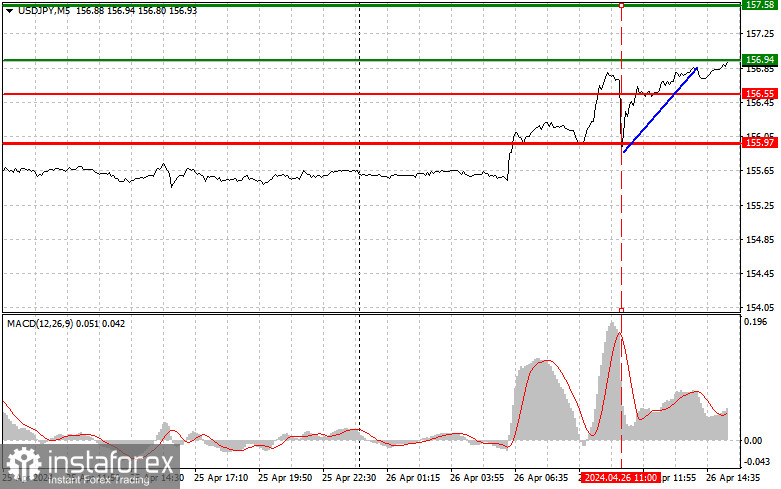Trade Analysis and Tips for Trading the Japanese Yen
The price test at 155.97 occurred when the indicator was in oversold territory, allowing the scenario for buying on a rebound to continue the upward trend for the dollar observed during the Asian session. As a result, the pair rose by more than 100 points. The decision of the Bank of Japan had a negative impact on the yen. Even interventions by the regulator did not help. Now, everything depends on the US data. Inflation indicators and their growth will lead to the strengthening of the dollar in continuation of the upward trend, while weak data will allow for another correction, similar to the first half of the day. But it's better to trade in the direction of the trend. As for the intraday strategy, I will rely more on scenarios #1 and #2.

Buy Signal
Scenario #1: Today, I plan to buy USD/JPY when the entry point reaches around 157.08 (green line on the chart) with the goal of rising to the level of 157.58 (thicker green line on the chart). At 157.58, I will exit the buys and open sells in the opposite direction, counting on a movement of 30-35 pips from the entry-level. Expecting growth in the pair today will only be possible after very strong US statistics. Important! Before buying, make sure that the MACD indicator is above the zero mark and only starting to rise from it.
Scenario #2: I also plan to buy USD/JPY today in case of two consecutive tests of the price at 156.66, at a time when the MACD indicator is in oversold territory. This will limit the pair's downward potential and lead to a reversal of the market upwards. Expect a rise to opposite levels of 157.08 and 157.58.
Sell Signal
Scenario #1: I plan to sell USD/JPY today after the level of 156.66 is updated (red line on the chart), which will lead to a rapid decrease in the pair. The key target for sellers will be the level of 155.97, where I will exit the sales and immediately open buys in the opposite direction, counting on a movement of 20-25 pips in the opposite direction from the level. Pressure on the pair will return in the event of an unsuccessful breakthrough of the daily maximum. Important! Before selling, make sure that the MACD indicator is below the zero mark and only starting to decline from it.
Scenario #2: I also plan to sell USD/JPY today in case of two consecutive tests of the price at 157.08, at a time when the MACD indicator is in overbought territory. This will limit the pair's upward potential and lead to a reversal of the market downward. Expect a decrease to opposite levels of 156.66 and 155.97.

What's on the chart:
Thin green line – entry price for buying the trading instrument;
Thick green line – anticipated price where you can set Take Profit or manually take profit, as further growth above this level is unlikely;
Thin red line – entry price for selling the trading instrument;
Thick red line – anticipated price where you can set Take Profit or manually take profit, as further decline below this level is unlikely;
MACD indicator. When entering the market, it is important to follow the overbought and oversold zones.
Important. Beginner traders in the Forex market need to be very cautious when making entry decisions. Before important fundamental reports are released, it is best to stay out of the market to avoid being caught in sharp exchange rate fluctuations. If you decide to trade during news releases, always place stop orders to minimize losses. You need to set stop orders to avoid losing your entire deposit, especially if you do not use money management and trade with large volumes.
And remember, successful trading requires a clear trading plan similar to the one I presented above. Spontaneous trading decisions based on the current market situation are initially a losing strategy for intraday traders.





















